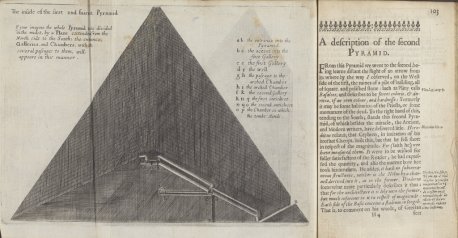Pyramidographia, or, A description of the pyramids in Egypt
Overview
Pyramidographia, or, A description of the pyramids in Egypt [ edit ]
Imagining the ancient Nile Valley was inextricable from recording its surviving monuments. From antiquity to the Renaissance, and even today, the sheer size of the Great Pyramid of Giza fosters speculation about its purpose. In 1646, John Greaves, a professor of astronomy at Oxford University, transformed earlier fanciful images into the first accurate elevation section of the Great Pyramid, seen here. Within Pyramidographia, Greaves uses all of the classical sources at his disposal, as well as Arabic writings; he correctly concluded (using the fifth century Greek historian Herodotus) that the Great Pyramid was the tomb of the pharaoh Khufu (now known to have ruled ca. 2589-2566 BCE).
Date
1646
Artist or Author
John Greaves (1602-1652)
Provenance
British
Museum
Yale British Art Center
Accession Number
DT63 G 73 1646












